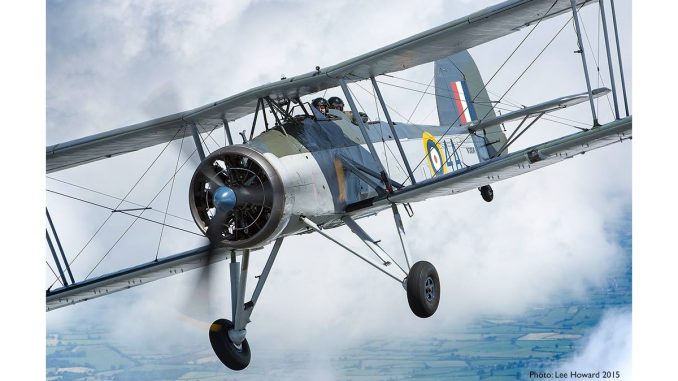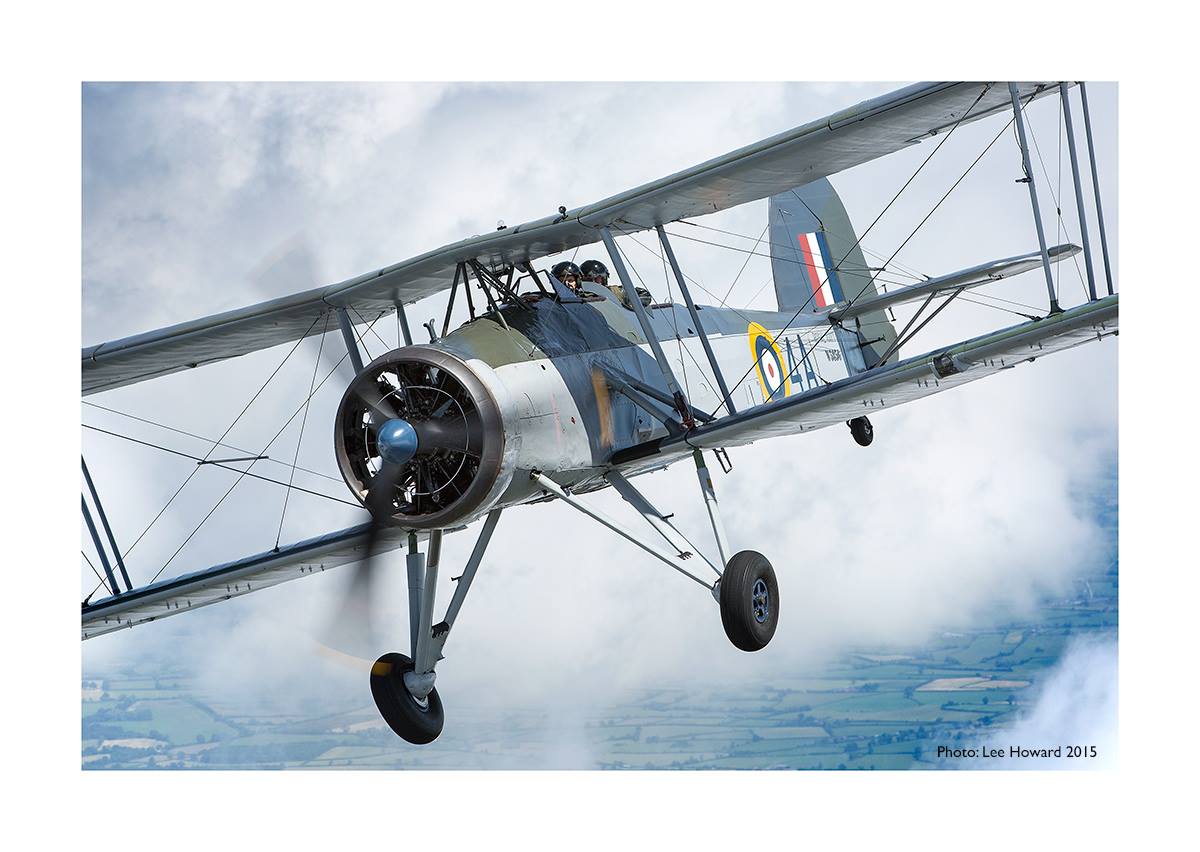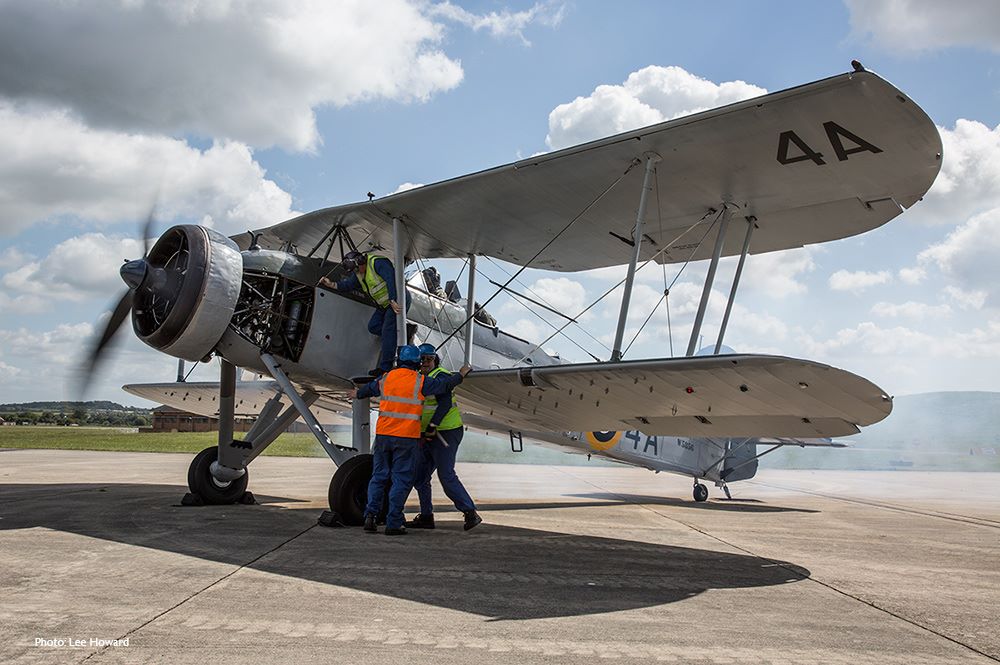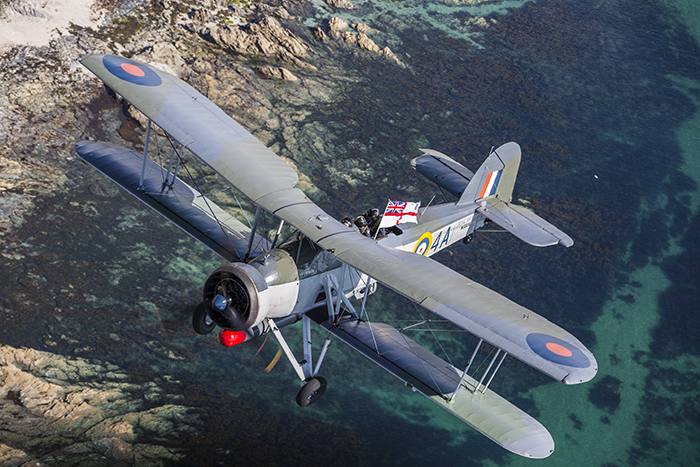

PRESS RELEASE – The historic Fairey Swordfish, an aircraft that sits at the heart of Britain’s naval aviation heritage, will lead the flypast over London on August 15th, 2015 to commemorate the 70th Anniversary of Victory over Japan Day (VJ Day) and the end of the Second World War. Built in 1941, and remarkably still flying 74 years later, Swordfish W5856 is the oldest surviving Swordfish Mk.I in the world, and is a living memorial to all those who have flown aircraft from ships at sea with the Royal Navy and Fleet Air Arm over the past 100 years.
The Swordfish played a crucial role protecting convoys from U-boat attack in the Battle of the Atlantic, sank the Italian fleet at Taranto and crippled the mighty Bismarck in the Northern Atlantic in 1941. Flying in her original 820 Naval Air Squadron paint scheme at the time of the attack on the Bismarck, Swordfish W5856 will fly over Horse Guards Parade at 2.00 pm in tribute to the sacrifice made by thousands of Allied soldiers, sailors and airmen in World War Two and particularly those who served in the ‘forgotten’ British Pacific Fleet that played a major role in the defeat of Japan at the end of the war. Fleet Air Arm Squadrons flying from aircraft carriers made a huge contribution to the defeat of Japan in the final months of the war. Describing how it felt to be in the thick of the fighting, months after Victory in Europe had been declared, veteran Firefly pilot, Donald Randle from Northleach, Gloucestershire said: “I was in 1771 Squadron in HMS Implacable at the time. We were flying intensive strikes on the Japanese mainland, with as many as eight Fireflies and twelve Seafires in a single strike. Anti-aircraft fire was fierce. Our sister carrier, HMS Indefatigable was also coming under Kamikaze attacks. We were preparing to attack some of the most heavily defended targets in Tokyo when the Japanese surrendered. I wasn’t looking forward to dodging balloon cables as well – and am very glad we didn’t have to!”
Swordfish takes to the sky The last airworthy Swordfish plane has taken to Somerset’s skies ahead of VJ Day commemorations this weekend. Based at Royal Naval Air Station Yeovilton, the historic aircraft will lead a flypast in London to mark 70 years since Victory over Japan.
Posted by BBC Points West on Wednesday, August 12, 2015
“The only British aircraft to attack Japan were operated by the Royal Navy from the decks of aircraft carriers,” continued Donald. “I will feel extremely proud watching the Swordfish lead the flypast. She symbolises our great carrier aviation heritage. I will also think of my brother, who had a terrible war in Burma.” Other surviving veterans of 820 Naval Air Squadron (flying Avengers), 887 and 894 Squadrons (flying Seafires) and 1772 (flying Fireflies) from HMS Indefatigable were in action against the Japanese right up to the end of the war, and beyond that, they were involved in ‘mercy missions’ dropping desperately needed supplies on prisoner of war camps on mainland Japan. Many did not return to the UK until months later.
Former Petty Officer, Norman (Dicky) Richardson (92) from Weybridge, Surrey, a Fleet Air Arm Air Gunner in 849 Naval Air Squadron aboard HMS Victorious, fought continuously for the last two years of the war without a single stand-down. “The Fleet Air Arm earned its place in history with the British Pacific Fleet,” said Norman. “I operated the turret gun in Avengers and flew on both the Palembang raids on Japanese oil fields in 1945. They were the biggest raids the Fleet Air Arm has ever done. The Japanese fighters were waiting for us the second time. It was our second major strike operation in five days. I was shot down off Sumatra.”

“Our losses were heavy that day. Enemy action cost six Avengers, two Corsairs and a Firefly. I was rescued by the destroyer HMS Whelp. ‘Prince Philip of Greece’ was the second in command and he had a joke with me at the Westminster Field of Remembrance last November saying he remembered fishing me out of the drink!” Norman, who will be attending the VJ Day service in Horse Guards, continued: “Victorious was hit several times by Kamikaze attacks. Those attacks were daunting. We just kept going. I flew over Japan twice on the last day of the war!” There were many individual acts of gallantry by naval aviators during the Pacific campaign. Lieutenant Robert ‘Hammie’ Gray, a Canadian Corsair pilot, received the Victoria Cross posthumously for leading an extraordinarily courageous strike on Japanese shipping off the island of Honshu on August 9th, 1945. Gray’s aircraft was hit and set on fire, but he resolutely pressed home a determined attack bombing his target before crashing into the sea.
“The Swordfish epitomizes the ethos and spirit of the Fleet Air Arm and the important part played by naval aircraft in the history of our country,” said Lieutenant Simon Wilson, Royal Navy, who will be flying the aircraft over London. “It is an honor flying the Swordfish on such a significant anniversary,” continued Simon. “With each passing year, fewer veterans of the Second World War remain amongst us. Keeping her flying ensures that all that they gave in the service of their country is not only recognized, but kept alive and passed on to future generations. The history of naval aviation lives on too. Swordfish W5856 is a direct link from the Bismarck, to 820 Naval Air Squadron flying Avengers in the Pacific campaign, right up to the present day 820 Squadron, which flies Merlin helicopters worldwide. It’s very emotional and poignant representing such a rich heritage.”

The Royal Navy’s historic aircraft are only partially funded by the Ministry of Defense with additional essential support provided by the Fly Navy Heritage Trust. Sue Eagles, Campaign Director for the Trust said, “In the last months of the war the British Pacific Fleet was the most powerful strike force in the history of the Royal Navy. How this was achieved by a nation nearing exhaustion after five years of conflict is due in no small measure to the commitment, tenacity and courage of the Fleet Air Arm. By keeping our historic naval aircraft flying, the Trust aims to bring the history of naval flying alive, giving the story of our naval aviation heritage relevance and meaning to young and old alike today.”
About The Royal Navy Historic Flight
The Royal Navy’s historic aircraft are supported by grants from the Fly Navy Heritage Trust. The Trust relies on public donations to fulfil its charitable mission to keep a collection of historic naval aircraft flying at air shows around the country to preserve and promote the nation’s naval aviation heritage. Swordfish W5856 was saved for the nation by a grant of £200,000 made to the Trust by the Peter Harrison Heritage Foundation in 2013. Further information on Swordfish W5856 and her recent rebuild and restoration is also available on request. The Fly Navy Heritage Trust is the charity which helps to fund the Royal Navy Historic Flight, as unlike the BBMF, the RNHF is not fully-funded by the Ministry of Defence and the main financial resources come from charitable donations made to the Fly Navy Heritage Trust. To visit the Royal Navy Historic Flight or donate to keep historic British naval aircraft flying, please call 01935 849200 or email sue.eagles@fnht.co.uk.
http://www.fnht.co.uk/
http://www.


My Dad Stephen Arthur de Mowbray was a trainee O/N in the FAA during WW2. He regularly flew in Swordfish, Albacore and Barracudas. is pilot in Swordfish was Laurence Olivier. It is Dad’s 90th birthday today, but sadly he is suffering from advanced Alzheimer’s and his memory has gone.
I saw this Swordfish flying over Tower Bridge many years ago, before its restoration. I think it was during the Tall Ships race, before the QE Bridge at Dartford was built.
I live in Southwark and am very keen to watch today’s flypast. Is it possible for you to tell me the scheduled route? I intend to go to the Thames embankment somewhere between Greenwich and Tower Bridge and would be keen to know if this will be a good viewing place.
Many thanks,
Marcus de Mowbray
Thanks very much for writing in. I’m sorry to hear that your father can no longer remember his experiences. We all owe him, and his compatriots, a great debt. Unfortunately, we do not have any details on the timing of the flyover, but it is sure to be noted elsewhere on the web. I wish you good luck in seeing the proceedings, and do hope you will write in here to describe what you see…
Marcus
I am trying to piece together our family tree. I believe your father may be the son of my great grandfather, Eric Guy Bohun De Mowbray who was also part of the Royal Navy… Please contact if you can help me piece the family together on my email address khemindra.nadarajah@gmail. Com
Cheers
Khemindra
Good researching Arhish.
Your spot on he is who you say he is.